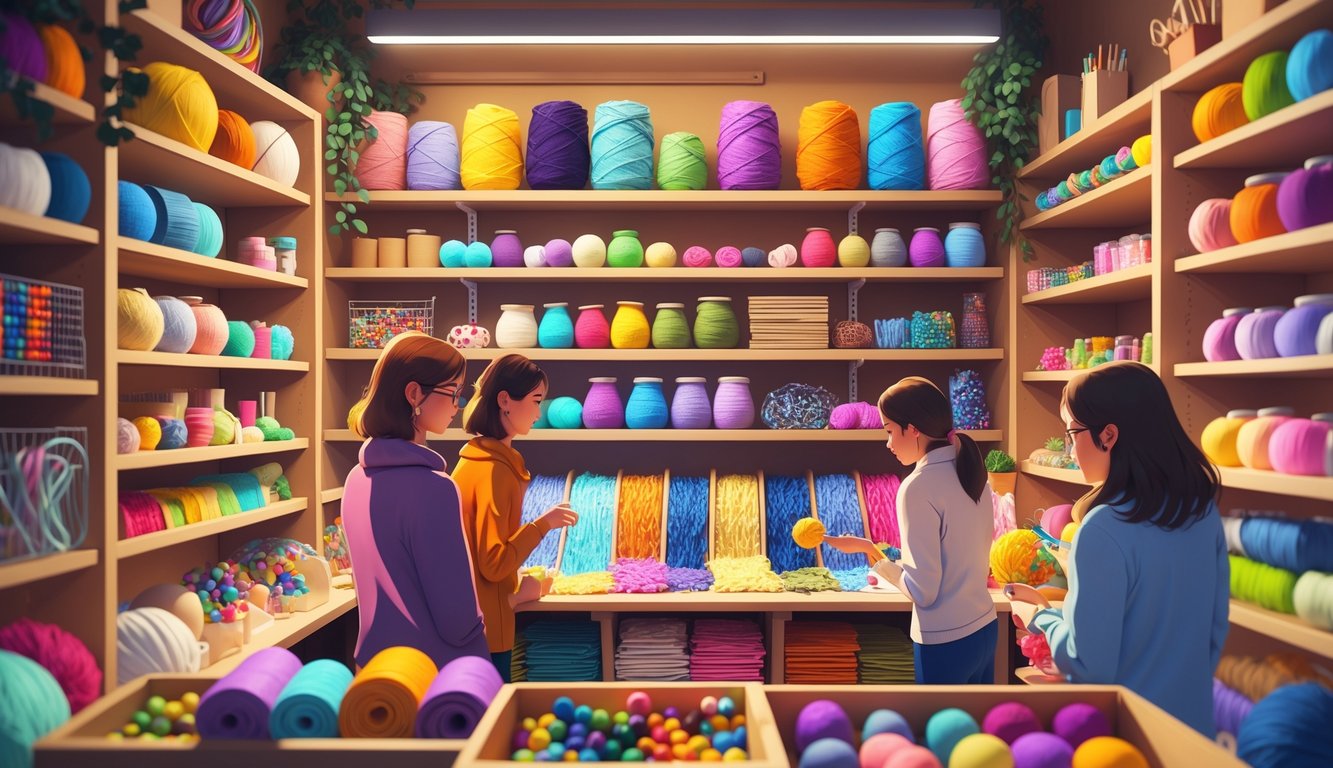
Expanding Creativity and Inspiration
Look, swapping isn’t just about saving money. I swear my brain works differently when I’m holding someone else’s random fabric offcuts. My own stuff? Boring. Nobody gets inspired staring at the same five yarn colors. When I get swap supplies, I have to make it work, or just give up and start something new. That’s the jolt I need when I’m stuck.
I remember swapping a box of unopened cross-stitch kits for a handful of rubber stamps. Suddenly I’m making greeting cards and everyone at craft club thinks I’ve had some creative epiphany. Nope, just guilt about wasting free stuff. Lindsay Thompson (she’s in that Craftsy trend report) said, “Unexpected supplies are the fastest shortcut to breaking old creative habits.” She’s right, but also, sometimes I just don’t want to buy more cardstock. Let’s be real.
Access to Unique Craft Supplies
You ever try to find weird, discontinued stuff at a big-box craft store? Good luck. They stock what sells, not what’s interesting. But at swaps, I’ve seen scrapbook paper from 2008, beads from someone’s grandma, embroidery floss colors that don’t even exist anymore. You can’t buy that new, and you definitely can’t find it in the “seasonal” aisle.
Ask any Craftster regular—they’ll say, “My boring stash is someone else’s jackpot.” I once traded metallic wool I hated for Japanese origami paper, and then three people wanted to know where I found it. Projects change because of these finds, and sometimes the results are so weird, not even the store managers could predict it.
Retailers act like they can’t do anything about this, but let’s be honest—they just can’t keep up with a thousand crafters swapping everything under the sun.
Popular Materials Exchanged in Craft Swaps
Missing bobbins, tangled gift wrap, boxes of leftovers—none of this is simple. Swap groups are full of the same questions, and you know retailers are watching, probably annoyed that none of this stuff is getting bought new. There’s no “main” material, but some things come up so often, I wonder why stores pretend we’re all buying kits at full price every time.
Fabric, Yarn, and Embroidery Supplies
Quilting cottons multiply on their own, I swear. Fat quarters, abandoned half-yards, tiny linen scraps—gone instantly at swaps. People trade designer fabric for a spool of embroidery floss and nobody even blinks. Yarn is chaos: discontinued colors, mystery fibers, bags of acrylic that haunt your stash for years. If you crochet, it’s currency; if you knit, you’re desperate to get rid of it. Supposedly, 53 million Americans are in this yarn game (thanks, Craft Yarn Council), so that’s a lot of swaps.
Embroidery stuff is the sleeper hit—hoops bought in bulk, unopened transfer pens, sampler kits with ducks nobody stitched. Last month I scored vintage DMC floss (the good French-made kind, not the weird knockoff). I think most of us swap embroidery thread for nostalgia, not because we need it—a single metallic skein can drag up memories of half-finished gifts and suddenly feels priceless.
Gift Wrap and Packaging Items
What fills the swap bins? Gift bags, cellophane, that ribbon you only need twice a year but always forget to buy. I once swapped a roll of metallic washi tape for five paper gift bags—no regrets. Retailers never seem to notice how fast their holiday wrapping ends up in swaps. One friend stopped buying tissue paper entirely; her stash is all secondhand now.
There’s always a box of plain brown tags—scrapbookers love them, so do people making party favors. Fancy gift wrap (Rifle Paper Co., Hallmark) disappears fast. Last winter I grabbed Japanese Furoshiki, which is both fabric and wrapping, so nobody could decide where to put it. Someone always leaves with 100 feet of tulle ribbon. No explanation, just swap logic.
Swapping for Specific Crafts: Knitting, Crochet, and More
Every time I try to clean my craft room, some random cotton skein and ancient embroidery floss turn up. If retailers wanted to keep people buying new stuff for every project—well, tough, because swaps blow that whole idea apart.
Knitting and Yarn Exchanges
Throwing out unused wool because you’re sick of the color? Wasteful, but that’s basically what “stash-busting” nights are for. At my fiber guild, someone traded a dozen hand-dyed mini-skeins for a whole Rowan sweater quantity. No one even cared.
Here’s what annoys me: Retailers push the “you need the latest sock yarn” thing, but swaps prove half the time, you already have what someone else wants. Ravelry has monthly swap threads—people post yardage, fiber, dye lot, it’s a spreadsheet party. Yarn isn’t even the end; tools get swapped too, but mailing blocking mats is a nightmare. Don’t try it.
Crochet and Fabric Swaps
Someone always claims granny squares need new yarn, but I’m over here gluing velvet scraps together “for future projects.” Fabric swaps at the library? They have bins for crochet cotton, felt, tapestry wool—so you don’t end up with glitter foam unless you really want it.
Online, Facebook swap groups are chaos: photos of half-used Red Heart, random linen fat quarters, even vintage steel hooks. My friend at the sewing shop says, “Label your yardage and fiber.” Otherwise, you’ll bring home twelve meters of mystery polyblend and wish you hadn’t. Retailers are probably thrilled.
Discovering Supplies for Handmade Items
I swapped rubber stamps for wool and somehow ended up with candle wicks and black floss for friendship bracelets. Happens every time. The swaps I join always devolve into barter madness: earring hooks for bag handles, half a bottle of Mod Podge for two rolls of washi tape. Retailers say you need a kit, but swaps just torch that idea.
People bring the weirdest things: shrink plastic, snap fasteners, unopened leather punches. Craft Industry Alliance says 43% of handmade sellers use at least one swapped or secondhand supply. Stuff never matches, but nobody cares on market day. There’s always someone trying to swap old glue sticks. Why is that allowed? No clue.



